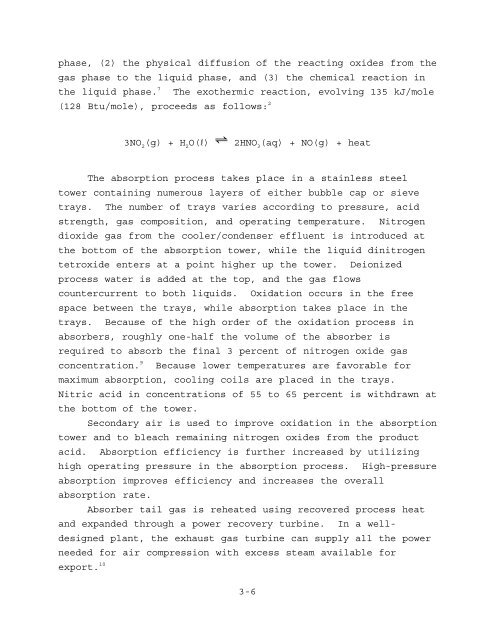Alternative Control Techniques Document— Nitric And Adipic Acid
Alternative Control Techniques Document— Nitric And Adipic Acid
Alternative Control Techniques Document— Nitric And Adipic Acid
Create successful ePaper yourself
Turn your PDF publications into a flip-book with our unique Google optimized e-Paper software.
phase, (2) the physical diffusion of the reacting oxides from the<br />
gas phase to the liquid phase, and (3) the chemical reaction in<br />
7<br />
the liquid phase. The exothermic reaction, evolving 135 kJ/mole<br />
(128 Btu/mole), proceeds as follows: 2<br />
3NO (g) + H O(R) º 2HNO (aq) + NO(g) + heat<br />
2 2 3<br />
The absorption process takes place in a stainless steel<br />
tower containing numerous layers of either bubble cap or sieve<br />
trays. The number of trays varies according to pressure, acid<br />
strength, gas composition, and operating temperature. Nitrogen<br />
dioxide gas from the cooler/condenser effluent is introduced at<br />
the bottom of the absorption tower, while the liquid dinitrogen<br />
tetroxide enters at a point higher up the tower. Deionized<br />
process water is added at the top, and the gas flows<br />
countercurrent to both liquids. Oxidation occurs in the free<br />
space between the trays, while absorption takes place in the<br />
trays. Because of the high order of the oxidation process in<br />
absorbers, roughly one-half the volume of the absorber is<br />
required to absorb the final 3 percent of nitrogen oxide gas<br />
9<br />
concentration. Because lower temperatures are favorable for<br />
maximum absorption, cooling coils are placed in the trays.<br />
<strong>Nitric</strong> acid in concentrations of 55 to 65 percent is withdrawn at<br />
the bottom of the tower.<br />
Secondary air is used to improve oxidation in the absorption<br />
tower and to bleach remaining nitrogen oxides from the product<br />
acid. Absorption efficiency is further increased by utilizing<br />
high operating pressure in the absorption process. High-pressure<br />
absorption improves efficiency and increases the overall<br />
absorption rate.<br />
Absorber tail gas is reheated using recovered process heat<br />
and expanded through a power recovery turbine. In a well-<br />
designed plant, the exhaust gas turbine can supply all the power<br />
needed for air compression with excess steam available for<br />
10<br />
export.<br />
3-6

















